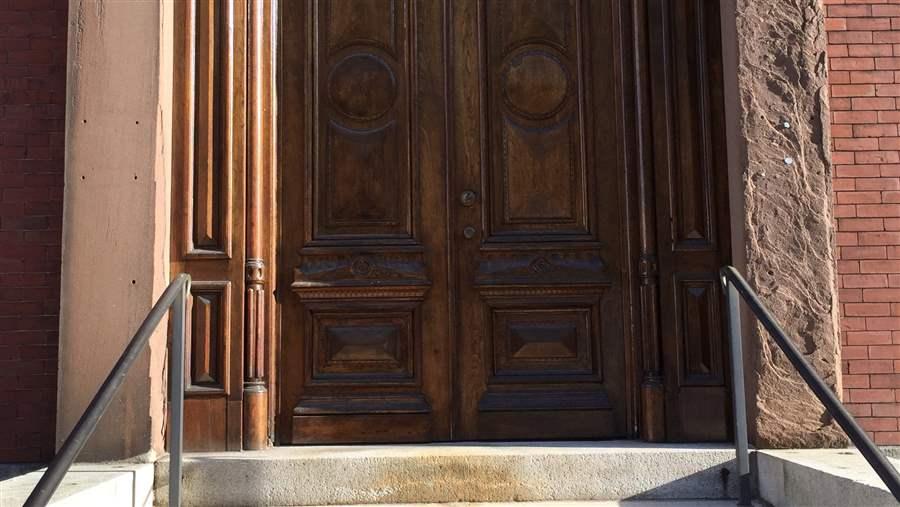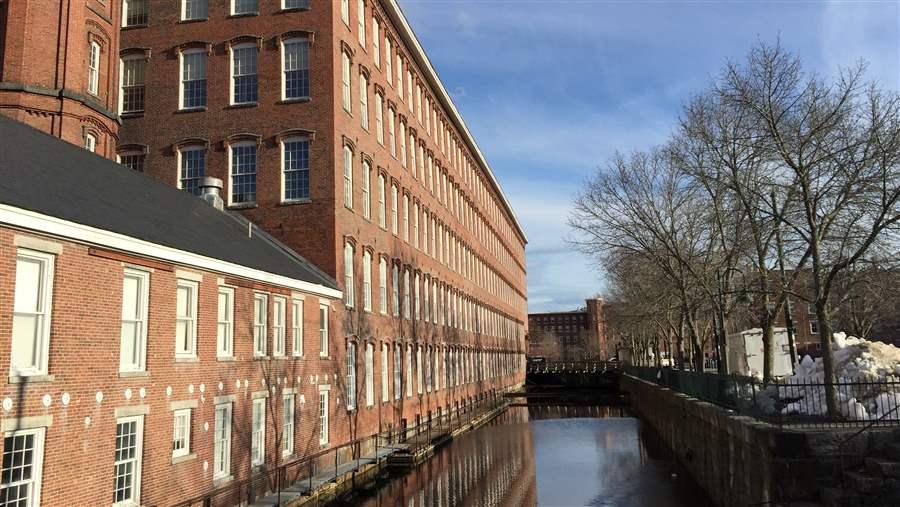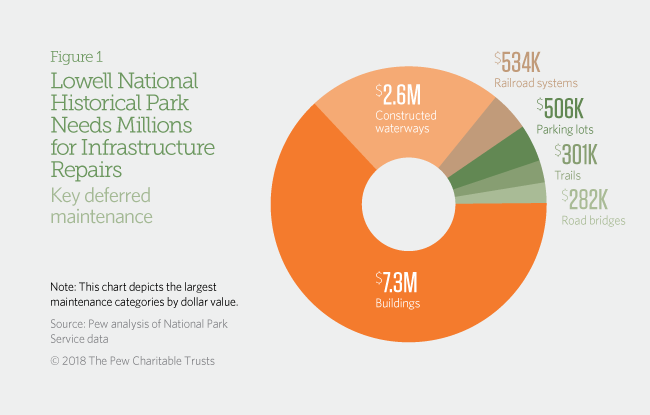Lowell National Historical Park
Massachusetts
Pew created this case study using National Park Service deferred maintenance data issued in fiscal year 2015. The information listed here may no longer reflect the NPS site’s current condition or maintenance requirements. To find the most up-to-date information, please use the National Park Repair Needs tool.
Overview
The beginning of the Industrial Revolution in the United States can be traced to innovations in the early 1800s by entrepreneur Francis Cabot Lowell and his partners, who revolutionized America’s fledgling textile industry. In the city in northeastern Massachusetts that now bears Lowell’s name, the men exploited local canals to power their textile looms and placed all textile production under one roof. Their need for American-made machines led to the development of master mechanics, who helped found other industries. And their need for workers encouraged women to leave nearby farms and, later, immigrants to leave their homelands. By 1850, the canals powered 40 mill buildings containing over 10,000 textile looms.
When the mills began closing after World War II, local, state, and federal partners urged Congress to make Lowell one of the country’s first urban national parks. The creation in 1978 of Lowell National Historical Park had the dual effect of preserving the city’s industrial history and serving as a catalyst for revitalization. Unfortunately, buildings have deteriorated, and the park faces a $12.1 million maintenance backlog.

Restoration of deteriorating masonry at the Kirk Street Agent’s House, which dates to 1846, is part of the park’s $12.1 million backlog of deferred maintenance.
Rebecca Harris
Maintenance challenges
Lowell National Historical Park says it lacks the funding to complete repairs to its 28 historic buildings, dozen gatehouses, pedestrian bridges, and miles of walkways and trails, along with other infrastructure. The majority of the park’s maintenance need ($7.3 million) is for its historic buildings, including Boott Mill #6, which now houses the Tsongas Industrial History Center. Replacing the mill’s windows, installed in the 1980s, with a type that requires less regular maintenance is challenging because over a third of them hang directly above a canal.
A pilot project designed and installed 60 windows in 2013, but the remainder need to be fabricated and installed by contractors using swing staging.
Although the canals are owned by a private power company, the park uses them for interpretation, including boat tours. The park has requested $1.1 million to repair the Pawtucket Canal, where it runs one of its boat tours. In the 1990s, a system of walkways was built along the tops of the canals, and they need to be maintained for the safety of residents and visitors.
While the city recognizes the park’s economic value, it can’t support the maintenance required to preserve it. More congressional funding is needed to address this gap.
The Lowell National Historical Park attracts thousands of visitors, including over 50,000 schoolchildren annually, because they want to experience firsthand our city’s impressive industrial heritage. Keeping the park safe, educational, and in good shape benefits Lowell residents and visitors alike.Former Lowell Mayor Ed Kennedy (D)
Recommendations
To address the deferred maintenance needs at Lowell and other National Park Service (NPS) sites in Massachusetts and across the country, Congress should:
- Ensure that infrastructure initiatives include provisions to address park maintenance.
- Provide dedicated annual federal funding for national park repairs.
- Enact innovative policy reforms to ensure that deferred maintenance does not escalate.
- Provide more highway funding for NPS maintenance needs.
- Create more opportunities for public-private collaboration and donations to help restore park infrastructure.
Lowell National Historical Park Facts
2016
| Visitor spending | $31.7 million |
| Jobs created by visitor spending | 467 |
| Economic output | $44.9 million |
| Labor income | $17.7 million |
| Visits | 541,285 |
| Deferred maintenance (fiscal year 2015) | $12.1 million |
Sources: National Park Service, “Visitor Spending Effects,” accessed Oct. 6, 2017, https://www.nps.gov/subjects/socialscience/vse.htm;
National Park Service, “NPS Deferred Maintenance Reports,” accessed Oct. 6, 2017, https://www.nps.gov/subjects/plandesignconstruct/defermain.htm.
© 2018 The Pew Charitable Trusts
The Pew Charitable Trusts works alongside the National Parks Conservation Association, the National Trust for Historic Preservation, and other national and local groups to ensure that our national park resources are maintained and protected for future generations to enjoy.















